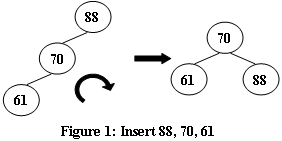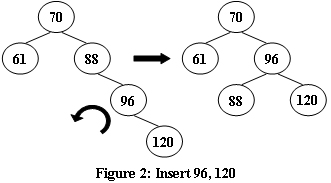04-树5 Root of AVL Tree(25 分)
An AVL tree is a self-balancing binary search tree. In an AVL tree, the heights of the two child subtrees of any node differ by at most one; if at any time they differ by more than one, rebalancing is done to restore this property. Figures 1-4 illustrate the rotation rules.




Input Specification:
Each input file contains one test case. For each case, the first line contains a positive integer N (≤20) which is the total number of keys to be inserted. Then N distinct integer keys are given in the next line. All the numbers in a line are separated by a space.
Output Specification:
For each test case, print the root of the resulting AVL tree in one line.
Sample Input 1:
5
88 70 61 96 120
Sample Output 1:
70
Sample Input 2:
7
88 70 61 96 120 90 65
Sample Output 2:
88#include <stdio.h>
#include <stdlib.h>
typedef struct AVLNode *AVLTree;
typedef struct AVLNode *Position;
struct AVLNode {
int Data;
int Height;
AVLTree Left;
AVLTree Right;
};
AVLTree Insert(int X, AVLTree T);
int GetHeight(Position T);
int Max(int a, int b);
Position SingleLeft(Position K);
Position SingleRight(Position K);
Position DoubleLeft(Position K);
Position DoubleRight(Position K);
int main(void) {
AVLTree T = NULL;
int n;
scanf("%d", &n);
while (n--) {
int x;
scanf("%d", &x);
T=Insert(x, T);
}
if (T)
printf("%d", T->Data);
return 0;
}
AVLTree Insert(int X, AVLTree T) {
if (T == NULL) {
T = (AVLTree)malloc(sizeof(struct AVLNode));
T->Data = X;
T->Height = 0;
T->Left = T->Right = NULL;
}
else if (X < T->Data) {
T->Left = Insert(X, T->Left);
if (GetHeight(T->Left) - GetHeight(T->Right) == 2) {
if (X < T->Left->Data)
T = SingleLeft(T);
else
T = DoubleLeft(T);
}
}
else if (X > T->Data) {
T->Right = Insert(X, T->Right);
if (GetHeight(T->Right) - GetHeight(T->Left) == 2) {
if (X > T->Right->Data)
T = SingleRight(T);
else
T = DoubleRight(T);
}
}
T->Height = Max(GetHeight(T->Left), GetHeight(T->Right)) + 1;
return T;
}
int GetHeight(Position T) {
if (!T)
return -1;
else
return T->Height;
}
int Max(int a, int b) {
return (a > b) ? a : b;
}
Position SingleLeft(Position K) {
Position Tmp;
Tmp = K;
K = K->Left;
Tmp->Left = K->Right;
K->Right = Tmp;
Tmp->Height = Max(GetHeight(Tmp->Left), GetHeight(Tmp->Right)) + 1;
K->Height = Max(GetHeight(K->Left), GetHeight(K->Right)) + 1;
return K;
}
Position SingleRight(Position K) {
Position Tmp;
Tmp = K;
K = K->Right;
Tmp->Right = K->Left;
K->Left = Tmp;
Tmp->Height = Max(GetHeight(Tmp->Left), GetHeight(Tmp->Right)) + 1;
K->Height = Max(GetHeight(K->Left), GetHeight(K->Right)) + 1;
return K;
}
Position DoubleLeft(Position K) {
K->Left = SingleRight(K->Left);
return SingleLeft(K);
}
Position DoubleRight(Position K) {
K->Right = SingleLeft(K->Right);
return SingleRight(K);
} 





















 4616
4616

 被折叠的 条评论
为什么被折叠?
被折叠的 条评论
为什么被折叠?








